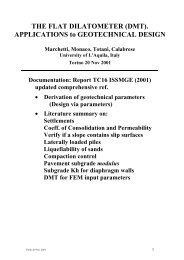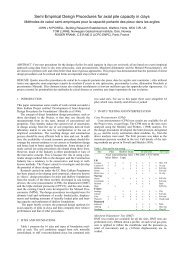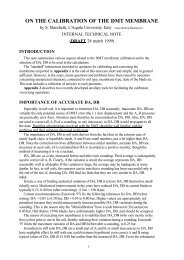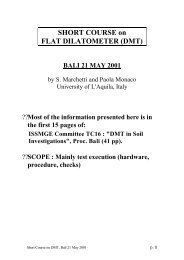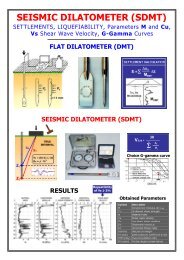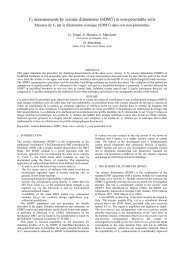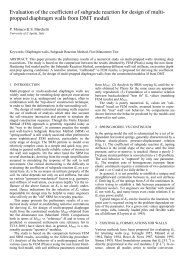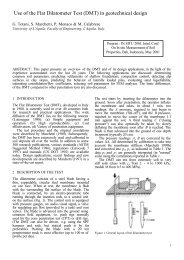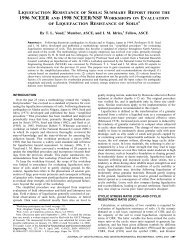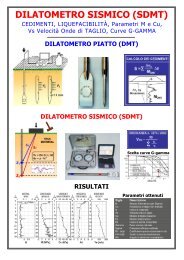The Flat Dilatometer Test (DMT) in Soil Investigations - Marchetti DMT
The Flat Dilatometer Test (DMT) in Soil Investigations - Marchetti DMT
The Flat Dilatometer Test (DMT) in Soil Investigations - Marchetti DMT
You also want an ePaper? Increase the reach of your titles
YUMPU automatically turns print PDFs into web optimized ePapers that Google loves.
c u = 0.22 σ' v0 (0.5 K D ) 1.25 (10)<br />
Eq. 10 has generally been found to be <strong>in</strong> an<br />
<strong>in</strong>termediate position between subsequent datapo<strong>in</strong>ts<br />
presented by various researchers (e.g. Lacasse &<br />
Lunne 1988, Powell & Uglow 1988). Example<br />
comparisons between c u <strong>DMT</strong> and c u by other tests at<br />
two research sites are shown <strong>in</strong> Figs. 22 and 23.<br />
Fig. 20. K 0 from <strong>DMT</strong>s and SBPTs <strong>in</strong> natural<br />
Tic<strong>in</strong>o sand at Pavia (Jamiolkowski 1995)<br />
Kemigawa<br />
Ohgishima<br />
Fig. 21. Correlation K D -D r for NC uncemented<br />
sands (after Reyna & Chameau 1991, also<br />
<strong>in</strong>clud<strong>in</strong>g Ohgishima and Kemigawa datapo<strong>in</strong>ts<br />
obta<strong>in</strong>ed by Tanaka & Tanaka 1998)<br />
"cementation"). An <strong>in</strong>convenience of the method is<br />
that it requires both <strong>DMT</strong> and CPT and proper<br />
match<strong>in</strong>g of correspondent K D and q c .<br />
11.1.4 Relative density D r (sand)<br />
In NC uncemented sands, the recommended relative<br />
density correlation is the one shown <strong>in</strong> Fig. 21 (Reyna<br />
& Chameau 1991), where D r is derived from K D . This<br />
correlation is supported by the additional K D -D r<br />
datapo<strong>in</strong>ts (also <strong>in</strong>cluded <strong>in</strong> Fig. 21) obta<strong>in</strong>ed by<br />
Tanaka & Tanaka (1998) at the Ohgishima and<br />
Kemigawa sites, where D r was determ<strong>in</strong>ed on high<br />
quality samples taken by the freez<strong>in</strong>g method.<br />
In OC sands or possibly <strong>in</strong> cemented sands, Fig. 21<br />
will overpredict D r , s<strong>in</strong>ce part of K D is due to the<br />
overconsolidation or cementation, rather than to D r .<br />
<strong>The</strong> amount of the overprediction is difficult to<br />
evaluate at the moment.<br />
11.2 STRENGTH PARAMETERS<br />
11.2.1 Undra<strong>in</strong>ed shear strength c u<br />
<strong>The</strong> orig<strong>in</strong>al correlation for determ<strong>in</strong><strong>in</strong>g c u from<br />
<strong>DMT</strong> (<strong>Marchetti</strong> 1980) is the follow<strong>in</strong>g:<br />
Fig. 22. Comparison between c u determ<strong>in</strong>ed by<br />
<strong>DMT</strong> and by other tests at the National Research<br />
Site of Bothkennar, UK (Nash et al. 1992)<br />
Fig. 23. Comparison between c u determ<strong>in</strong>ed by<br />
<strong>DMT</strong> and by other tests at the National Research<br />
Site of Fuc<strong>in</strong>o, Italy (Burghignoli et al. 1991)<br />
23



